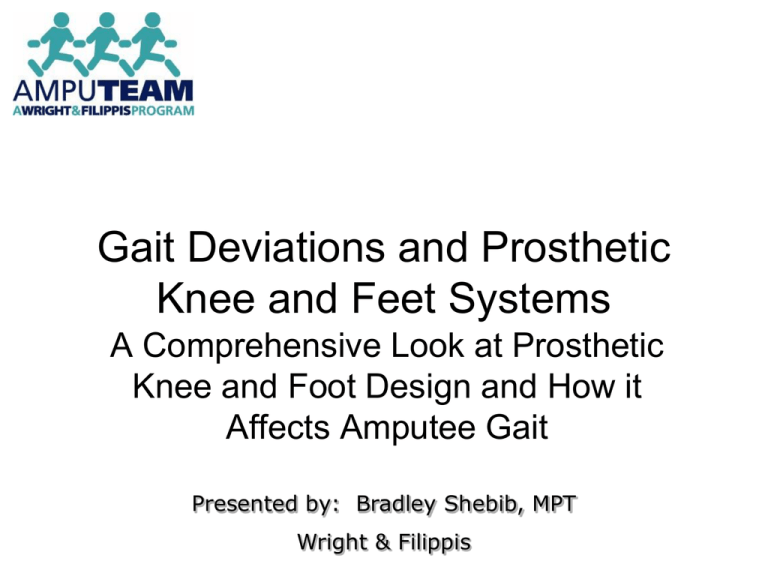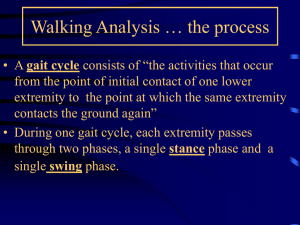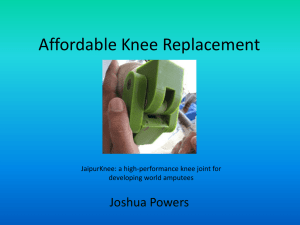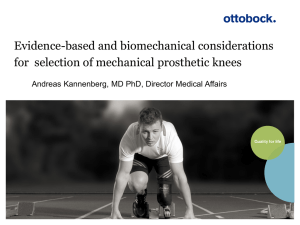Gait Deviations and Prosthetic Knee and Feet Systems
advertisement

Gait Deviations and Prosthetic Knee and Feet Systems A Comprehensive Look at Prosthetic Knee and Foot Design and How it Affects Amputee Gait Presented by: Bradley Shebib, MPT Wright & Filippis Prosthetic Feet and Knees Patient Evaluation • Amputation level • Activity level prior to amputation • Patient goals post amputation • Expected impact on prosthesis • Cosmetic concerns • Medicare functional levels • Insurance formularies Prosthetic Feet and Knees Activity Levels • Evaluation of the patient’s lifestyle prior to amputation. • Return to pre-amputation function? • Patient goals and motivation post amputation. • Realistic expected outcomes. • Important to distinguish activity level from expected impact on the prosthesis. Prosthetic Feet and Knees Additional Factors • Cosmetic concerns of the patient • Types of footwear preferred • Insurance concerns • Several highly functional and technologically advanced feet will not be approved by some insurance companies. Prosthetic Feet and Knees Medicare Functional Levels • Implemented to define a patient’s potential functional level. • Adopted by private insurance companies as the standard measure of potential. • Levels 0 through 4 • The patient’s functional level will govern the selection of the type of foot used. Prosthetic Feet and Knees Medicare Functional Levels • Measurement of patient potential to accomplish his/her expected, post-rehabilitation, daily function. • K0 is not a prosthetic candidate Prosthetic Feet and Knees Functional Levels/K Codes K3 K1 Potential household ambulator Community ambulator with the potential for variable cadence Walking from couch to bedroom Working, walking, hiking Very Low Moderate K2 K4 Potential limited community ambulator High activity user which exceeds normal ambulation skills Walking from house to neighbor’s house Low Running, sports High Prosthetic Feet and Knees Pediatrics Children are considered K4 patients due to their normal activities. Prosthetic Feet and Knees Bi-laterals Bi-laterals are exempt from the Functional Level/K-Coding system due to the unique stresses upon their prostheses. Most rehab professionals are unaware of this which leads to underprescribing and continuous failures. Prosthetic Feet Prosthetic feet should provide the following functions: • Joint simulation • Shock absorption • A stable weight-bearing base of support • Muscle simulation • Cosmesis Prosthetic Feet Prosthetic Feet Classifications • S.A.C.H: K1-2, low level can’t do BAPs board because can’t compile to uneven surface. • Single Axis • Multi-Axial • Energy Storing • Some prosthetic feet incorporate a combination of classifications. Prosthetic Feet S.A.C.H. (Solid Ankle Cushioned Heel) • • • • • • • Consists of a solid wood or aluminum internal keel extending to the toe break The keel is surrounded by a molded external foam foot with cosmetic toes and a cushioned heel wedge. No moveable parts. Plantar flexion is replaced by the compression of the heel wedge. Shock absorption at heel strike is very good. SACH feet provide excellent stability. Historically fit to low active patients and used in postoperative prostheses. Prosthetic Feet S.A.C.H. (Solid Ankle Cushioned Heel) Advantages: •Moderate weight •Good durability •No moving components •Minimal maintenance •Good shock absorption for moderately active patients. Disadvantages: •Limited plantar flexion and dorsi-flexion adjustability. •The heel cushion deteriorates over time. •Heel cushion may loose elasticity •Poor shock absorption for high active patients. Prosthetic Feet S.A.C.H. – Gait Deviations (Solid Ankle Cushioned Heel) 1. Soft heel cushion will create strong extension moment at the knee 2. Lack of strong toe lever limits how long stability is maintained through stance 3. Limited adaptability to different surfaces Prosthetic Feet Single Axis Feet • Contains a solid wood internal keel, a molded foam rubber shell, a metal single axis joint, a rubber plantar flexion bumper, and a dorsiflexion stop. • Ankle plantar flexion and dorsiflexion are provided in the rotation about the ankle joint. • Offers shock absorption at heel strike through the plantar flexion bumper, which is available in multiple durometers. • Stance-phase stability is excellent because the foot in in contact with the ground for a long period of time Prosthetic Feet Single Axis Feet Advantages: •The plantar flexion capability provides increased knee stability at heel strike and foot flat and may lessen the difficulty of descending inclines •Plantar flexion resistance can be varied Disadvantages: •Relatively high maintenance due to moving components •Increased weight •Less cosmetic •Tendency to “squeak” Prosthetic Feet Single Axis Feet – Gait Deviations 1. Plantarflexion will create strong extension moment at the knee 2. Limited adaptability to variable surfaces 3. Lower energy return Prosthetic Feet Flexible Keel Feet • Contains a keel made of a flexible material. • The compliant keel aids in shock absorption. • Multi-terrain uses • Water safe applications • Low cost Prosthetic Feet Multi-Axial Feet The multi-axial foot provides motion in all three planes, making it particularly suitable for patients who walk on uneven terrain. 1 3 2 4 Prosthetic Feet Multi-Axial Feet Advantages: •Allows motion is all planes Disadvantages: •Increased weight •Reduces torque on the residual •Increased maintenance limb •Adjustability Prosthetic Feet Energy Storing Modern materials have made it possible for prosthetic feet to absorb, store, and release energy. Prosthetic Feet Energy Storing Advantages: •Extremely light weight •All activity levels can benefit •Longer stride •Less oxygen consumption •Exceptional shock absorption •Excellent cosmesis •Individually customized Disadvantages: •Misconception that Energy Storing Feet are only appropriate for the high active patients •Higher cost/reimbursement scale Prosthetic Feet Multi-Axial, Energy Storing Feet – Gait Deviations 1. Higher adaptability to uneven surfaces 2. Depending on length of heel and toe lever, will see strong extension/flexion moment at the knee 3. Increased energy return leads to more dynamic gait Prosthetic Feet Medicare Levels and Prosthetic Feet Options Any SACH foot or Single Axis Foot Any flexible keel foot or multiaxial foot Prosthetic Feet Medicare Levels and Prosthetic Feet Options A Flex foot system, energy storing foot, multiaxial ankle/foot, dynamic response or flex walk system Above Knee Categories • Joint Type - Single Axis - Polycentric Axis • Swing Control Mechanism - Constant Friction - Fluid Control • Stance Control Mechanism - Manual Lock - Friction Pad - Fluid Control Friction vs Hydraulic Control Constant Friction Knees - LESS DYNAMIC SWING CONTROL SYSTEM - Less speed variability due to friction control - If High Friction: 1. will see more posterior pelvic tilt and hip thrust to fight resistance 2. Will see lower heel rise on prosthetic side - If Low Friction: 1. will see more “flipping” of leg, rebounding from terminal extension before heel contact 2. Will see higher heel rise on prosthetic side Friction vs Hydraulic Control Hydraulic Knees - MORE DYNAMIC KNEE CONTROL SYSTEM - Patient can expect greater speed variability - IF HYDRAULICS TOO STIFF: 1. Pt will complain of “walking through mud” 2. Lower heel rise, more posterior tilt to fight through resistance - IF HYDRAULICS TOO LOOSE: 1. Pt will experience excessive heel rise 2. Pt will aggressively extend knee, having difficulty controlling terminal knee extension Single Axis – Weight Activated Stance Control Knee • Two Types of Swing Control - Constant Friction - Hydraulic/Pneumatic • Two Types of Forefoot Unloading - Breaks the knee without un-weighting - Must un-weight to get knee flexion • Medicare Functional Level – K2 or Below (with one exception) Single Axis – Weight Activated Stance Control Knee Constant Friction Hydraulic/Pneumatic K1 or K2 K1, K2 OR K3 K1 or K2 NONE Forefoot Unloading No Forefoot Unloading Single Axis – Weight Activated Stance Control Knee - MAKE SURE to have patient weight shift to prosthetic side to secure loading of weight activated brake. This is true of all W.A.S. systems!! - Tendency to “sit back” on sound side, wait for prosthesis to hit ground. LESS SAFE WITH THIS SYSTEM Single Axis – W.A.S. Expected Gait Deviations • Constant Friction/No Forefoot Load - MOST LIMITED OF W.A.S. KNEES - Hip Hike needed to unweight the prosthesis - Tendency to circumduct prosthetic side - Inconsistent knee extension moment due to no geometric lock - Tendency to “sit back” on sound side, wait for prosthesis to hit ground. LESS SAFE WITH THIS SYSTEM - Increased time on sound side noted Single Axis – W.A.S. Expected Gait Deviations • Constant Friction/Forefoot Loading - No Hip hike needed to unweight prosthesis - Less circumduction during swing phase - Increased time on prosthetic side which reduces stress on sound side Single Axis – W.A.S. Expected Gait Deviations • Hydraulic/Forefoot Loading - NO hip hike needed due to forefoot loading - Further reduction in circumduction Polycentric Knees • Two Types of Swing Control - Constant Friction - Hydraulic/Pneumatic • Options with Stance Flexion Feature - Some have stance flexion through bumper system from heel contact to midstance • Medicare Functional Levels - K2 or below for friction knees - K3 or above for hydraulic/pneumatic knees Polycentric Knees Constant Friction K1 or K2 Hydraulic/Pneumatic K3 or above Stance Flexion K1 or K2 K3 or above No Stance Flexion Polycentric Knees – Expected Gait Deviations - Delayed gait to wait for sound of terminal knee extension – common with all polycentric knees - “flipping” of knee – using distal end of residual limb to disengage stance lock and swing the leg -Powerful hip extension moment at heel contact to ensure locking of knee through midstance - PATIENT NEEDS mild hip flexion “pop” to overcome geometric lock of knee system Polycentric Knees – Expected Gait Deviations • Constant Friction - DEPENDING ON FRICTION SETTING – will either see excessive heel rise, toe drag, or excessive hip flexion moment to overcome resistance. - AT HIGHER SPEEDS – you will notice a firm terminal impact, causing delayed heel contact - AT LOWER SPEEDS – you will notice difficulty reaching terminal impact prior to heel contact - MAKE SURE FRICTION ADJUSTMENT IS APPROPRIATE FOR INDIVIDUAL PATIENT Polycentric Knees – Expected Gait Deviations • Constant Friction/No Stance Flexion - More “pole vaulting” due to lack of stance flexion feature - More “thumping” of sound side as patient comes down off of prosthetic limb - Slowest patient speed expected, most patient fatigue throughout training session Polycentric Knees – Expected Gait Deviations • Constant Friction/Stance Flexion - Less “pole vaulting” due to stance flexion feature - Less “thumping” of sound side as patient is able to maintain smoother center of gravity through midstance - Higher patient speed expected, decreased patient fatigue throughout training session due to more controlled gait pattern Polycentric Knees – Expected Gait Deviations • Hydraulic/No Stance Flexion - “pole vaulting” over prosthetic side due to no stance flexion • Hydraulic/Stance Flexion Knees - less “pole vaulting” needed if patient allows stance flexion to occur Single Axis – Hydraulic/Pneumatic • Wide Variety of Knee Systems - Examples – C-Leg, Mauch, Rheo Knee • Medicare Functional Level - All K3 or Above Single Axis, Hydraulic/Pneumatic – Expected Gait Deviations • Hydraulic/Pneumatic Resistance Influences Gait Expectations - IF TOO STIFF – fluid drag will cause pt to increase hip hike/flexion to propel prosthesis. Pt feels like they are “dragging through mud” - IF TOO LOOSE – decreased stance time on prosthetic side due to lack of overall confidence, feeling of knee instability Single Axis, Hydraulic/Pneumatic – Expected Gait Deviations • Hydraulic/Pneumatic Resistance Influences Gait Expectations - IF TOO STIFF – may see lack of heel rise, powerful “flip” of prosthesis to propel leg. - IF TOO LOOSE – May see excessive heel rise, difficulty reaching terminal impact at heel contact, thus slowing gait down to allow leg to catch up. Single Axis, Hydraulic/Pneumatic – Expected Gait Deviations • Ability to disengage hydraulics increases activity variability - Mauck, C-Leg, Rheo will “shut off” hydraulics if patient achieves hyperextension moment at toe off. Allows for easier swing of knee. - If no hyperextension, pt will “ride” the hydraulics, increasing energy expenditure through swing phase. Single Axis, Hydraulic/Pneumatic – Expected Gait Deviations • Ability to engage stance control increases patient confidence - Otto Bock 3R80 is free swinging unless weight is put on leg, then hydraulic resistance kicks in for controlled knee flexion. - Different from W.A.S. as weight doesn’t lock prosthesis, only offers more controlled movement. How Can We As Physical Therapists Help Maximize Patient Outcomes With Their Respective Knee Systems? Maximizing Patient Outcomes • Know the knee system prior to starting treatment • Talk to the prosthetist about any adjustments made prior to starting treatment • Monitor patient gait deviations and ask that adjustments be made as the patient progresses • Tailor your expectations to each individual knee system QUESTIONS???




